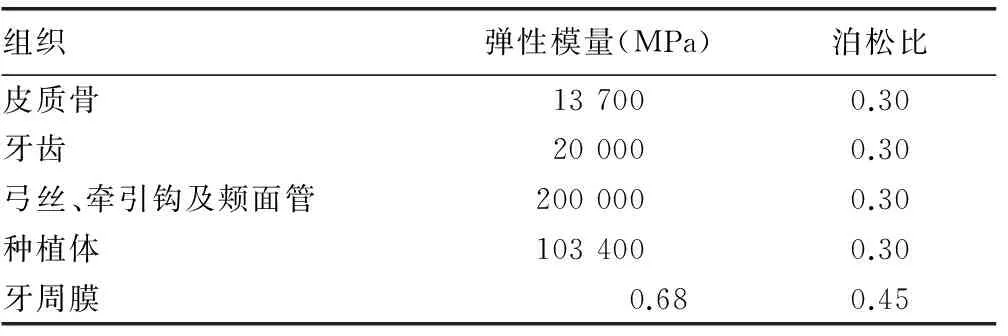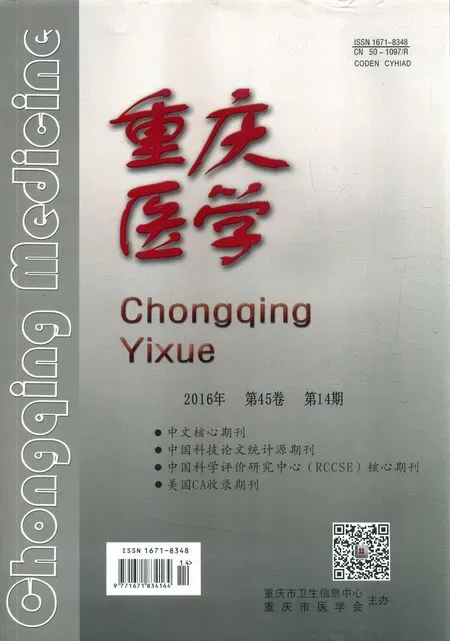種植體支抗關閉拔牙間隙磨牙位移趨勢的有限元研究*
何 淞,王亞楠,瞿 楊,楊四維,黃 躍
(西南醫科大學口腔醫學院,四川瀘州 646000)
?
論著·基礎研究
種植體支抗關閉拔牙間隙磨牙位移趨勢的有限元研究*
何淞,王亞楠,瞿楊,楊四維,黃躍△
(西南醫科大學口腔醫學院,四川瀘州 646000)

牙種植體;有限元分析;支架;滑動法;上頜第一磨牙;初始位移
滑動法關閉拔牙間隙作為直絲弓矯治技術的特征之一,已被廣泛地應用于正畸臨床治療中。種植體支抗作為絕對支抗被臨床公認為是一種可以有效增強支抗的方法[1]。對于需要最大限度內收前牙的患者,使用種植體支抗關閉拔牙間隙時也應注意上頜支抗磨牙的應力變化。以往對滑動法關閉拔牙間隙的三維有限元研究主要集中在前牙[2-3],很少關注支抗磨牙的位移,在使用種植體支抗時,支抗磨牙是否發生三維方向的位移變化,以及它的受力情況值得研究。因此,本研究應用三維有限元方法模擬臨床不同種植體高度及不同牽引鉤高度,滑動法關閉拔牙間隙時上頜第一磨牙的Von Mises等效應力及位移變化趨勢,以期為臨床應用提供參考。
1 材料與方法

1.2方法
1.2.1建立有限元模型使用螺旋CT掃描機對成年男性志愿者全頭顱進行連續掃描。將獲得的掃描圖像導入Mimics10.01軟件,應用Geomagic Studio 10.0軟件、PRO/E.Wildfire 4.0軟件建立種植體-牽引鉤-托槽-弓絲-上頜牙列的實體模型,弓絲尺寸為0.46 mm×0.64 mm(0.019 in×0.025 in)不銹鋼方絲。將種植體支抗距離弓絲6、8、10、12 mm的高度植入上頜第二前磨牙及第一磨牙間,分別與不同牽引鉤高度(1、4、7、10 mm)等元件組裝,生成4組模型。將各元件網格劃分后導入MSC.Marc.Mentat 2005R3軟件中進行參數定義、邊界設定,最終得到種植體-牽引鉤-托槽-弓絲-上頜牙列的有限元模型。
1.2.2材料屬性和力學加載設定所建模型為連續、均質、各向同性的線彈性材料,假設弓絲牽引鉤、頰面管的材料屬性一致。各模型彈性模量及泊松比見表1[4]。

表1 相關材料的彈性模量和泊松比
1.2.3載荷將不同高度的種植體及牽引鉤進行兩兩組合,共計16種工況。在各工況的牽引鉤高度上沿著種植體方向施加1.5 N的力。
1.3計算在上頜第一磨牙上選取以下點:近中頰尖點、遠中頰尖點、近中舌尖點、遠中舌尖點、近中頰根根尖點、遠中頰根根尖點、腭根根尖點。在MSC.Marc.Mentat 2005R3軟件中分別收集這7點在X軸、Y軸、Z軸三維方向上的位移變化趨勢(X軸代表矢狀向,Y軸代表冠狀向,Z軸代表垂直向)[5-6]。
2 結 果
2.1上頜第一磨牙的Von Mises等效最大應力分布(1)模型1是不同牽引鉤高度在種植體高度為6 mm時上頜第一磨牙的應力變化。其Von Mises等效最大應力分別為:工況A為1.16×10-4KP;工況B為1.24×10-4KP;工況C為1.31×10-4KP;工況D為1.37×10-4KP。(2)模型2是不同牽引鉤高度在種植體高度為8 mm時上頜第一磨牙的應力變化。其Von Mises等效最大應力分別為:工況A為1.16×10-4KP;工況B為1.19×10-4KP;工況C為1.27×10-4KP;工況D為1.33×10-4KP。(3)模型3是不同牽引鉤高度在種植體高度為10 mm時上頜第一磨牙的應力變化。其Von Mises等效最大應力分別為:工況A為1.05×10-4KP;工況B為1.16×10-4KP;工況C為1.22×10-4KP;工況D為1.29×10-4KP。(4)模型4是不同牽引鉤高度在種植體高度為12 mm時上頜第一磨牙的應力變化。其Von Mises等效最大應力分別為:工況A為0.98×10-4KP;工況B為1.08×10-4KP;工況C為1.33×10-4KP;工況D為1.43×10-4KP。當種植體高度大于或等于牽引鉤高度時,上頜第一磨牙Von Mises等效最大應力分布主要集中在近中面頸部、腭根腭側及根分叉處,其中根分叉處最大;當種植體高度小于牽引鉤高度時(即模型1的工況C、D,模型2的工況D),Von Mises等效最大應力分布主要集中在近中面頸部、頰側頸部及根分叉處,其中根分叉處最大,見圖1~4。

A:牽引鉤高度為 1 mm;B:牽引鉤高度為4 mm;C:牽引鉤高度為7 mm;D:牽引鉤高度為10 mm。
圖1模型1 種植體高度為6 mm時上頜第一磨牙Von Mises等效應力分布云圖

A:牽引鉤高度為 1 mm;B:牽引鉤高度為4 mm;C:牽引鉤高度為7 mm;D:牽引鉤高度為10 mm。
圖2模型2 種植體高度為8 mm時上頜第一磨牙Von Mises等效應力分布云圖

A:牽引鉤高度為 1 mm;B:牽引鉤高度為4 mm;C:牽引鉤高度為7 mm;D:牽引鉤高度為10 mm。
圖3模型3 種植體高度為10 mm時上頜第一磨牙Von Mises等效應力分布云圖

A:牽引鉤高度為 1 mm;B:牽引鉤高度為4 mm;C:牽引鉤高度為7 mm;D:牽引鉤高度為10 mm。
圖4模型4 植體高度為12 mm時上頜第一磨牙Von Mises等效應力分布云圖
2.2上頜第一磨牙位移變化趨勢
2.2.1牙齒頰舌向位移變化趨勢X軸的位移:近頰尖與近舌尖均為負值,遠頰尖與遠舌尖均為正值,遠頰根位移大于近頰根,且隨著牽引鉤高度的增加位移值隨之變大。當種植體高度大于或等于牽引鉤高度時,近頰尖的位移小于近舌尖,遠頰尖的位移小于遠舌尖;小于牽引鉤高度時,近頰尖的位移大于近舌尖,遠頰尖的位移大于遠舌尖,見圖5。
2.2.2牙齒近遠中向位移變化趨勢Y軸的位移:只有腭根點為負值,且遠中頰舌尖點均小于近中頰舌尖點,其位移值隨牽引鉤高度的增加而增大;但當種植體高度小于牽引鉤高度時,其位移值隨之減小。腭根的位移小于近頰根,見圖6。

A:種植體高度為6 mm,上頜第一磨牙在牽引鉤高度分別為1、4、7、10 mm;B:種植體高度為8 mm,上頜第一磨牙在牽引鉤高度分別為1、4、7、10 mm;C:種植體高度為10 mm,上頜第一磨牙在牽引鉤高度分別為1、4、7、10 mm;D:種植體高度為12 mm,上頜第一磨牙在牽引鉤高度分別為1、4、7、10 mm。
圖5X軸位移趨勢圖(×E-06rad)

A:種植體高度為6 mm,上頜第一磨牙在牽引鉤高度分別為1、4、7、10 mm;B:種植體高度為8 mm,上頜第一磨牙在牽引鉤高度分別為1、4、7、10 mm;C:種植體高度為10 mm,上頜第一磨牙在牽引鉤高度分別為1、4、7、10 mm;D:種植體高度為12 mm,上頜第一磨牙在牽引鉤高度分別為1、4、7、10 mm。
圖6Y軸位移趨勢圖(×E-06rad)

A:種植體高度為6 mm,上頜第一磨牙在牽引鉤高度分別為1、4、7、10 mm;B:種植體高度為8 mm,上頜第一磨牙在牽引鉤高度分別為1、4、7、10 mm;C:種植體高度為10 mm,上頜第一磨牙在牽引鉤高度分別為1、4、7、10 mm;D:種植體高度為12 mm,上頜第一磨牙在牽引鉤高度分別為1、4、7、10 mm。
圖7Z軸位移趨勢圖(×E-06rad)
3 討 論
3.1支抗磨牙位移的研究頭影測量是以往學者對于種植體支抗滑動法關閉拔牙間隙時牙齒的位移變化研究的常用方法。其中,Park 等[7]和Poberts[8]發現磨牙頰面管與弓絲之間的摩擦力會導致磨牙向遠中移動。尋春雷等[9]學者提出在滑動法關閉間隙中磨牙會向近中移動。頭影測量存在影像重疊、無法精確定位等缺點,影響結果的準確性。三維有限元可從三維方向分析牙齒移動的生物力學機制,比以往測量方法更精準。本研究采用三維有限元方法,分析種植體支抗滑動法關閉拔牙間隙時上頜第一磨牙的生物力學變化,推斷上頜第一磨牙的受力情況,為臨床矯治提供理論依據。
3.2上頜第一磨牙最大應力分布情況的討論本研究選用的Von Mises等效應力對牙周膜應力分布進行力學性能分析[10],發現第一磨牙的最大應力均出現在根分叉處,當種植體高度大于或等于牽引鉤高度時,應力集中于近中面頸部、腭根腭側及根分叉處;小于牽引鉤高度時,應力分布在牙周膜頰側頸部,這與張菊菊等[11]的研究結果“上頜第一磨牙在根分叉處可見高的應力集中”相似。結果中應力分布從大到小依次是磨牙表面、牙槽骨、牙周膜,這主要與材料的彈性模量有關,彈性模量越大,應力越大,這與Viecilli等[12]的研究結果一致。Xue等[13]指出Von Mises等效應力最大值為 26×103Pa,超出此應力值牙周膜將發生壞死。本研究結果中應力值均小于26×103Pa。

綜上所述,上頜第一磨牙在X軸、Y軸、Z軸上的整體位移變化趨勢為:當種植體高度大于或等于牽引鉤高度時,牙冠出現遠中旋轉并向遠中、頰側傾斜;小于牽引鉤高度時,牙冠出現遠中旋轉并向遠中、舌側傾斜。亦提示在臨床矯治時為防止磨牙過度的傾斜,應注意對磨牙轉矩的控制。
[1]Upadhyay M,Yadav S,Nagaraj K,et al.Dentoskeletal and soft tissue effects of mini-implants in Class Ⅱ division 1 patients[J].Angle Orthod,2009,79(2):240-247.
[2]安曉莉,陳宏偉,司慶宗.搖椅弓滑動法整體內收上頜前牙的三維有限元分析[J].華西口腔醫學雜志,2013,32(1):21-25.
[3]Sung SJ,Jang GW,Chun YS,et al.Effective en-masse retraction design with orthodontic mini-implant anchorage:a finite element analysis[J].Am J Orthod Dentofacial Orthop,2010,137(5):648-657.
[4]Tominaga JY,Tanaka M,Koga Y,et al.Optimal loading conditions for controlled movement of anterior teeth in sliding mechanics[J].Angle Orthod,2009,79(6):1102-1107.
[5]Wang CY,Su MZ,Chang HH,et al.Tension-compression viscoelastic behaviors of the periodontal ligament[J].J Formos Med Assoc,2012,111(9):471-481.
[6]Aversa R,Apicella D,Perillo L,et al.Non-linear elastic three-dimensional finite element analysis on the effect of endocrown material rigidity on alveolar bone remodeling process[J].Dent Mater,2009,25(5):678-690.
[7]Park HS,Bae SM,Kyuang HM,et al.Micro-implant anchorage for treatment of skeletal Class Ⅰ bialveolar protrusion[J].J Clin Orthod,2001,35(7):417-422.
[8]Poberts WE.When planning to use an implant for anchorage,how long do you have to wait to apply force after implant placement[J].Am J Orthod Dentofacial Orthop,2002,121(1):14A.
[9]尋春雷,曾祥龍,王興.微型自攻鈦釘種植體支抗壓低切牙的初步應用研究[J].口腔正畸學,2004,11(1):29-31.
[10]Ashish H,NikhilH,Vinay PR,et al.Effect of the thread pitch of orthodontic mini-implant on bone stress-a 3d finite element analysis[J].J Dent,2011,1(4):91-96.
[11]張菊菊,段銀鐘,霍娜,等.3種不同施力方式遠移上頜第一磨牙牙周膜應力的三維有限元分析[J].口腔醫學研究,2006,22(2):166-168.
[12]Viecilli RF,Budiman A,Burstone CJ.Axes of resistance for tooth movement:does the center of resistance exist in 3-dimensional space? [J].Am J Orthod Dentofacial Orthop,2013,143(2):163-172.
[13]Xue J,Ye N,Yang X,et al.Finite element analysis of rapid canine retraction through reducing resistance and distraction[J].J Appl Oral Sci,2014,22(1):52-60.
[14]Solem RC,Marasco R,Guiterrez-Pulido L,et al.Three-dimensional soft-tissue and hard-tissue changes in the treatment of bimaxillary protrusion[J].Am J Orthod Dentofacial Orthop,2013,144(2):218-228.
[15]Koyama I,Iino S,Abe Y,et al.Differences between sliding mecha-nics with implant anchorage and straight-pull headgear and inter-maxillary elastic in adults with bimaxillary protrusion[J].Eur J Orthod,2011,33(2):126-131.
[16]盧燕勤,高雪梅.直絲弓矯治器滑動法關閉間隙的三維非線性有限元研究[J].天津醫藥,2010,39(6):461-463.
Tree-dimensional finite element analysis of displacement tendency of maxillary molar during closing maxillary extraction space with implant anchorage*
HeSong,WangYanan,QuYang,YangSiwei,HuangYue△
(StomatologySchool,SouthwestMedicalUniversity,Luzhou,Sichuan646000,China)
ObjectiveTo analyse the tendency of maxillary first molar′s initial stress distribution and displacement during closing maxillary extraction space in sliding mechanics with implants.MethodsWe created a three dimensional finite element model and simulated the clinic closing maxillary extraction space in sliding mechanics with implants.A protraction force of 1.5 N was applied.Implants were located at different height (6,8,10,12 mm) and crampable hooks at different height (1,4,7,10 mm).Then we analysed the initial displacement and the tendency of distribution.ResultsWhen the heights of implants were greater than or equal to crampable hooks,the maximum stress located in root furcation areas;when the heights of implants were smaller than the crampable hooks,the stress distributing in buccal cervical part,the minimum stress located in palatal side of palatal root.The displacement tendency of the first molars was as follow.X axis:the movement tendency of molar was distal rotation,the rotation angle of the first molars increased with heights of crampable hooks.Y axis:the movement tendency of molar was distal tipping and distal rotation,the rotation angle of molar increased with heights of crampable hooks.Z axis:the movement of molar was extrusion movement at mesial part and intrusion movement at distal part,the displacements of the molar were increased with heights of crampable hooks.ConclusionThe stress changes of maxillary first molar are associated with the heights of implants and the crampable hooks.The displacement tendency of maxillary first molar is distal tip and rotation,the direction of tip is associated with the heights of implants and the crampable hooks.
dental implants;finite element analysis;stents;sliding mechanics;maxillary first molar;initial displacement
10.3969/j.issn.1671-8348.2016.14.005
國家自然科學基金青年基金項目(81300903);川大-瀘州戰略合作項目(2013CDLZ-S22)。作者簡介:何淞(1989-),在讀碩士,主要從事口腔正畸生物力學研究。△
,E-mail:yue-huang@hotmail.com。
R783.5
A
1671-8348(2016)14-1886-03
2015-11-28
2016-01-24)

